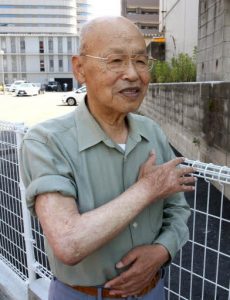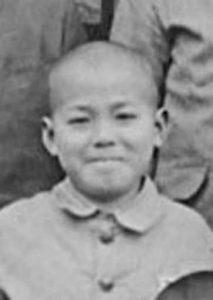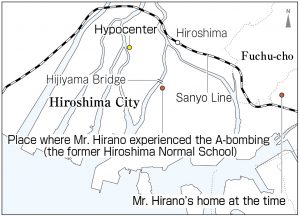Survivors’ Stories: Sadao Hirano, 87, Aki Ward, Hiroshima: Leading my life with keloids
Jul. 6, 2020
by Kyoko Niiyama, Staff Writer
Sadao Hirano, now 87, suffered burns to about a quarter of his body because of the thermal rays from the atomic bombing when he was 12 years old. He always feels pain from the keloid scars that developed as a result of his bad burns. With scars that have remained all his life, he shares his account with children, saying, “I want you to know the sufferings of the A-bomb survivors, which began the day the atomic bomb was dropped on Hiroshima.”
In 1945, Mr. Hirano was a first-year student at the Hiroshima Prefectural Hiroshima Commercial School (now Hiroshima Prefectural Hiroshima Commercial High School). On the morning of August 6, he was in the school yard of the former Hiroshima Normal School, located in Minami-machi (now part of Minami Ward). He was getting ready to go to the site, along with his classmates, where they were mobilized to work, helping to tear down buildings to create fire lanes. When he was heading for the platform for the morning assembly as a teacher made the roll call, he was suddenly bathed in a brilliant orange flash of light.
Mr. Hirano said, “I felt as if my body were being sizzled for a few seconds.” He was about 2 kilometers from the hypocenter. All around him was darkness and a cloud of dust, the initial blast from the A-bomb made it hard to stand, and it became difficult for him to breathe. When he saw his classmates, their lips were red and swollen and their clothes were burned to tatters. Two of his classmates and he took refuge on Hijiyama Hill nearby, embracing each other.
There was a big air-raid shelter at the foot of the hill, but it had already been packed with people. Voices crying out things like “It’s so hot! It’s killing me!” were echoing in there. When Mr. Hirano tried to drink water from a stream running nearby, his skin, which was burnt and melted, stretched tight, and he was unable to sit down. He had a soldier, right near him, cut off a blister at the back of the knee with a dagger.
In the evening, he reached his home in Funakoshi-cho (now part of Aki Ward). He suffered burns to his entire right arm, left arm, neck, back, and a part of his foot. His peeled skin that was hanging from his fingertips had already become a solid black chunk. His mother, Chieko, used scissors to cut off finger skin that had been stuck together.
Mr. Hirano was unconscious for a few days after he came home because of the unbearable pain. The flesh of his arm suffered a gash and bone was visible. Maggots festered in his wounds, but Chieko took care of him devotedly, putting sake, oil, and the squeezed juice of cucumber on his entire body.
About two months after the atomic bombing, the school reopened. Most of his classmates suffered burns, though not as terrible as Mr. Hirano’s. They had no classes. When he was carrying pieces of scrap wood in the charred ruins of the city center, his thin skin bled many times.
The school system underwent reform when Mr. Hirano was a second-year student, and he entered Kanon High School and graduated from it in 1951. He got a job at the Hiroshima Credit Union (now Hiroshima Shinkin Bank) at the age of 18. When he met a bank customer away from the bank, he found the customer looking at his keloids on his arms when he wore short-sleeved uniform. He thought the customer would think he was disgusting and felt sad, but he first said, “I experienced the atomic bombing.”
Mr. Hirano got married at the age of 26 and had two children. He worked until he retired at the age of 55, enduring the pain of his wounds and supported by his family. He had a heart attack, and when he underwent his third operation, he wondered, for the first time, if he would be allowed to die without conveying the horrors of nuclear weapons. He pressed on with his life, trying not to remember the day when the atomic bomb was dropped on Hiroshima, but an A-bomb survivor living near his home encouraged him to share his A-bomb account, and he began to do so.
So far, he has shared his account with students visiting Hiroshima on school trips and children around the world 234 times. At first, he hid the keloids on his arms, but now he purposely exposes them because he wants people to know the horrors of the atomic bombing.
As he became old sharing his account became physically demanding. Still, he gathers up all his strength to say to children, “We don’t need any atomic bomb. There shouldn’t be war.”
I want to live my life with his serious words
Mr. Hirano said, stroking the keloids on his arm, “Every day my wounds hurt while I am awake. When I’m sleeping, it’s like paradise.” I imagine it was really hard for him to battle those painful wounds. Nevertheless, he said, “No matter how tough your life may be, you must not kill yourself.” His words were serious. No matter what difficulties I may face, I want to live with a positive attitude. (Atsuhito Ito, 17)
I knew the senselessness of war
Looking back on the misery of that time, Mr. Hirano said, “People were forced to injure somebody because of the war. This is the most terrible thing.” I came to understand how senseless and terrible war is. He said, “We need to make efforts to keep a peaceful world,” with which I sympathized. I decided to make an opportunity to think about the importance of peace with my family members and friends. (Yui Morimoto, 16)
(Originally published on July 6, 2020)
Purposely exposing a symbol of horrors
Sadao Hirano, now 87, suffered burns to about a quarter of his body because of the thermal rays from the atomic bombing when he was 12 years old. He always feels pain from the keloid scars that developed as a result of his bad burns. With scars that have remained all his life, he shares his account with children, saying, “I want you to know the sufferings of the A-bomb survivors, which began the day the atomic bomb was dropped on Hiroshima.”
In 1945, Mr. Hirano was a first-year student at the Hiroshima Prefectural Hiroshima Commercial School (now Hiroshima Prefectural Hiroshima Commercial High School). On the morning of August 6, he was in the school yard of the former Hiroshima Normal School, located in Minami-machi (now part of Minami Ward). He was getting ready to go to the site, along with his classmates, where they were mobilized to work, helping to tear down buildings to create fire lanes. When he was heading for the platform for the morning assembly as a teacher made the roll call, he was suddenly bathed in a brilliant orange flash of light.
Mr. Hirano said, “I felt as if my body were being sizzled for a few seconds.” He was about 2 kilometers from the hypocenter. All around him was darkness and a cloud of dust, the initial blast from the A-bomb made it hard to stand, and it became difficult for him to breathe. When he saw his classmates, their lips were red and swollen and their clothes were burned to tatters. Two of his classmates and he took refuge on Hijiyama Hill nearby, embracing each other.
There was a big air-raid shelter at the foot of the hill, but it had already been packed with people. Voices crying out things like “It’s so hot! It’s killing me!” were echoing in there. When Mr. Hirano tried to drink water from a stream running nearby, his skin, which was burnt and melted, stretched tight, and he was unable to sit down. He had a soldier, right near him, cut off a blister at the back of the knee with a dagger.
In the evening, he reached his home in Funakoshi-cho (now part of Aki Ward). He suffered burns to his entire right arm, left arm, neck, back, and a part of his foot. His peeled skin that was hanging from his fingertips had already become a solid black chunk. His mother, Chieko, used scissors to cut off finger skin that had been stuck together.
Mr. Hirano was unconscious for a few days after he came home because of the unbearable pain. The flesh of his arm suffered a gash and bone was visible. Maggots festered in his wounds, but Chieko took care of him devotedly, putting sake, oil, and the squeezed juice of cucumber on his entire body.
About two months after the atomic bombing, the school reopened. Most of his classmates suffered burns, though not as terrible as Mr. Hirano’s. They had no classes. When he was carrying pieces of scrap wood in the charred ruins of the city center, his thin skin bled many times.
The school system underwent reform when Mr. Hirano was a second-year student, and he entered Kanon High School and graduated from it in 1951. He got a job at the Hiroshima Credit Union (now Hiroshima Shinkin Bank) at the age of 18. When he met a bank customer away from the bank, he found the customer looking at his keloids on his arms when he wore short-sleeved uniform. He thought the customer would think he was disgusting and felt sad, but he first said, “I experienced the atomic bombing.”
Mr. Hirano got married at the age of 26 and had two children. He worked until he retired at the age of 55, enduring the pain of his wounds and supported by his family. He had a heart attack, and when he underwent his third operation, he wondered, for the first time, if he would be allowed to die without conveying the horrors of nuclear weapons. He pressed on with his life, trying not to remember the day when the atomic bomb was dropped on Hiroshima, but an A-bomb survivor living near his home encouraged him to share his A-bomb account, and he began to do so.
So far, he has shared his account with students visiting Hiroshima on school trips and children around the world 234 times. At first, he hid the keloids on his arms, but now he purposely exposes them because he wants people to know the horrors of the atomic bombing.
As he became old sharing his account became physically demanding. Still, he gathers up all his strength to say to children, “We don’t need any atomic bomb. There shouldn’t be war.”
Teenagers’ impressions
I want to live my life with his serious words
Mr. Hirano said, stroking the keloids on his arm, “Every day my wounds hurt while I am awake. When I’m sleeping, it’s like paradise.” I imagine it was really hard for him to battle those painful wounds. Nevertheless, he said, “No matter how tough your life may be, you must not kill yourself.” His words were serious. No matter what difficulties I may face, I want to live with a positive attitude. (Atsuhito Ito, 17)
I knew the senselessness of war
Looking back on the misery of that time, Mr. Hirano said, “People were forced to injure somebody because of the war. This is the most terrible thing.” I came to understand how senseless and terrible war is. He said, “We need to make efforts to keep a peaceful world,” with which I sympathized. I decided to make an opportunity to think about the importance of peace with my family members and friends. (Yui Morimoto, 16)
(Originally published on July 6, 2020)









